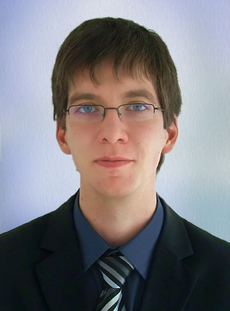Zur Person
Geburtsort Berlin
Nationalität deutsch
Berufliche Laufbahn
seit 2011
wissenschaftlicher Mitarbeiter am Institut für Prozessrechentechnik, Automation und Robotik
Masterarbeit
„Sollwertgenerierung unter kinematischen Beschränkungen für gemischt translatorische und rotatorische Bewegungen zu je drei Freiheitsgraden im euklidischen Raum“ – Technische Universität Ilmenau, Fakultät für Informatik und Automatisierung, Fachgebiet Systemanalyse
2009 – 2011
Masterstudium Mechatronik an der Technischen Universität Ilmenau
Bachelorarbeit
„Basketball spielen mit anthropromorphen Robotern“ – Deutsches Zentrum für Luft- und Raumfahrt, Institut für Robotik und Mechatronik
2005 – 2009
Bachelorstudium Mechatronik an der Technischen Universität Ilmenau
Forschungsprojekte
ACTIVE
The ACTIVE project exploits ICT and other engineering methods and technologies for the design anddevelopment of an integrated redundant robotic platform for neurosurgery. A light and agile redundant roboticcell with 20 degrees-of-freedom (DoFs) and an advanced processing unit for pre- and intra-operative control willoperate both autonomously and cooperatively with surgical staff on the brain.As the patient will not be considered rigidly fixed to the operating table and/or to the robot, the system will pushthe boundaries of the state of the art in the fields of robotics and control for the accuracy and bandwidth requiredby the challenging and complex surgical scenario.
Two cooperating robots will interact with the brain that will deform for the tool contact, blood pressure, breathing and deliquoration. Human factors are considered by allowing easy interaction with the users through a novelhaptic interface for tele-manipulation and by a collaborative control mode ("hands-on"). Active constraints will limit and direct tool tip position, force and speedpreventing damage to eloquent areas, defined on realistic tissue models updated on-the-field through sensorsinformation. The active constraints will be updated (displaced) in real time in response to the feedback fromtool-tissue interactions and any additional constraints arising from a complex shared workspace. The overarchingcontrol architecture of ACTIVE will negotiate the requirements and references of the two slave robots.
The operative room represents the epitome of a dynamic and unstructured volatile environment, crowded withpeople and instruments. The workspace will thus be monitored by environmental cameras, and machine learning techniques will be used for the safe workspace sharing. Cognitive skills will help to identify the target location in the brain and constrain robotic motionsby means of on-field observations.

